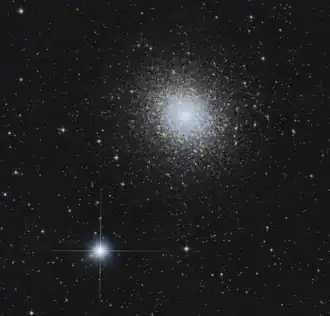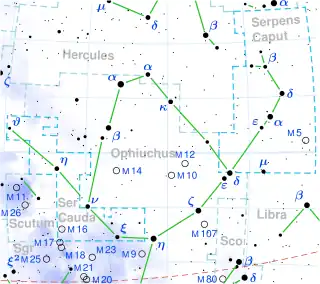5 Serpentis

5 Serpentis is a wide binary star[15] system in Serpens Caput, the western section of the equatorial constellation of Serpens. It is faintly visible to the naked eye with an apparent visual magnitude of 5.10. Based upon an annual parallax shift of 39.8 mas as viewed from Earth's orbit, it is located 82 light years away. The brighter member is an IAU radial velocity standard star,[16] and it is moving away from the Sun with a heliocentric radial velocity of +54.3 km/s. The system made its closest approach to the Sun about 153,000 years ago at a separation of 68 ly (20.7 pc).[9]
The primary, component A, is an F-type subgiant star with a stellar classification of F8 IV,[6][7] a star that has exhausted its core hydrogen and is evolving to become a red giant. The star was once thought to be a BY Draconis variable with the variable star designation MQ Ser,[17] but has been found not to be.[18] From observations made between 1975 and 1980, Bakos (1983) reported random, small brightness variations with an amplitude of less than 0.03 magnitude, plus three flare events that increased the brightness by 0.1 magnitudes.[19] However, Scarfe (1985) noted that these observations may instead be due to normal observational error.[16]
The common proper motion companion, component B, is a magnitude 10.1 star at an angular separation of 11.4″ along a position angle of 35°. It has an estimated orbital period of 3,371 years.[15] According to Hoffleit (1991), if this is a variable star it may account for the observations of Bakos (1983).[20]
References
- ^ Roman, Nancy G. (1987). "Identification of a constellation from a position". Publications of the Astronomical Society of the Pacific. 99 (617): 695. Bibcode:1987PASP...99..695R. doi:10.1086/132034. Constellation record for this object at VizieR.
- ^ a b c d e f g Vallenari, A.; et al. (Gaia collaboration) (2023). "Gaia Data Release 3. Summary of the content and survey properties". Astronomy and Astrophysics. 674: A1. arXiv:2208.00211. Bibcode:2023A&A...674A...1G. doi:10.1051/0004-6361/202243940. S2CID 244398875. Gaia DR3 record for this source at VizieR.
- ^ a b c d e f Luck, R. Earle (2017). "Abundances in the Local Region II: F, G, and K Dwarfs and Subgiants". The Astronomical Journal. 153 (1): 21. arXiv:1611.02897. Bibcode:2017AJ....153...21L. doi:10.3847/1538-3881/153/1/21.
- ^ a b c d e f Vallenari, A.; et al. (Gaia collaboration) (2023). "Gaia Data Release 3. Summary of the content and survey properties". Astronomy and Astrophysics. 674: A1. arXiv:2208.00211. Bibcode:2023A&A...674A...1G. doi:10.1051/0004-6361/202243940. S2CID 244398875. Gaia DR3 record for this source at VizieR.
- ^ Reiners, Ansgar; Zechmeister, Mathias (2020). "Radial Velocity Photon Limits for the Dwarf Stars of Spectral Classes F-M". The Astrophysical Journal Supplement Series. 247 (1): 11. arXiv:1912.04120. Bibcode:2020ApJS..247...11R. doi:10.3847/1538-4365/ab609f.
- ^ a b Gray, R. O.; et al. (2001). "The Physical Basis of Luminosity Classification in the Late A-, F-, and Early G-Type Stars. I. Precise Spectral Types for 372 Stars". The Astronomical Journal. 121 (4): 2148–2158. Bibcode:2001AJ....121.2148G. doi:10.1086/319956. S2CID 117076031.
- ^ a b c d Mallik, Sushma V.; et al. (October 2003). "Lithium and rotation in F and G dwarfs and subgiants". Astronomy and Astrophysics. 409: 251–261. Bibcode:2003A&A...409..251M. doi:10.1051/0004-6361:20031084.
- ^ a b c d e Houdebine, Éric R.; Mullan, D. J.; Doyle, J. G.; de la Vieuville, Geoffroy; Butler, C. J.; Paletou, F. (2019). "The Mass-Activity Relationships in M and K Dwarfs. I. Stellar Parameters of Our Sample of M and K Dwarfs". The Astronomical Journal. 158 (2): 56. arXiv:1905.07921. Bibcode:2019AJ....158...56H. doi:10.3847/1538-3881/ab23fe.
- ^ a b Anderson, E.; Francis, Ch. (2012). "XHIP: An extended hipparcos compilation". Astronomy Letters. 38 (5): 331. arXiv:1108.4971. Bibcode:2012AstL...38..331A. doi:10.1134/S1063773712050015. XHIP record for this object at VizieR.
- ^ a b Stassun, Keivan G.; et al. (2019). "The Revised TESS Input Catalog and Candidate Target List". The Astronomical Journal. 158 (4): 138. arXiv:1905.10694. Bibcode:2019AJ....158..138S. doi:10.3847/1538-3881/ab3467.
- ^ Maldonado, J.; et al. (May 2012). "Metallicity of solar-type stars with debris discs and planets⋆". Astronomy & Astrophysics. 541: 10. arXiv:1202.5884. Bibcode:2012A&A...541A..40M. doi:10.1051/0004-6361/201218800. S2CID 46328823. A40.
- ^ Baliunas, Sallie; Sokoloff, Dmitry; Soon, Willie (1996). "Magnetic Field and Rotation in Lower Main-Sequence Stars: An Empirical Time-dependent Magnetic Bode's Relation?". The Astrophysical Journal. 457 (2): L99 – L102. Bibcode:1996ApJ...457L..99B. doi:10.1086/309891.
- ^ a b Hardegree-Ullman, Kevin K.; Apai, Dániel; Bergsten, Galen J.; Pascucci, Ilaria; López-Morales, Mercedes (2023). "Bioverse: A Comprehensive Assessment of the Capabilities of Extremely Large Telescopes to Probe Earth-like O2 Levels in Nearby Transiting Habitable-zone Exoplanets". The Astronomical Journal. 165 (6): 267. arXiv:2304.12490. Bibcode:2023AJ....165..267H. doi:10.3847/1538-3881/acd1ec.
- ^ "5 Ser". SIMBAD. Centre de données astronomiques de Strasbourg. Retrieved 2018-03-17.
- ^ a b Tokovinin, Andrei (April 2014). "From Binaries to Multiples. II. Hierarchical Multiplicity of F and G Dwarfs". The Astronomical Journal. 147 (4): 14. arXiv:1401.6827. Bibcode:2014AJ....147...87T. doi:10.1088/0004-6256/147/4/87. S2CID 56066740. 87.
- ^ a b Scarfe, C. D. (August 1985). "On the Velocity Variability of 5-SERPENTIS and Omicron-Aquilae". Journal of the Royal Astronomical Society of Canada. 79 (595): 180. Bibcode:1985JRASC..79..180S.
- ^ Kholopov, P. N.; et al. (1985). "The 67th Name-List of Variable Stars". Information Bulletin on Variable Stars. 2681: 1. Bibcode:1985IBVS.2681....1K.
- ^ VSX; Otero, S. A. (13 November 2011). "MQ Serpentis". AAVSO Website. American Association of Variable Star Observers. Retrieved 18 July 2014.
- ^ Bakos, G. A. (May 1983). "Flare activity in two F-type stars, 5 Ser and ο Aql". Astronomical Journal. 88: 674–677. Bibcode:1983AJ.....88..674B. doi:10.1086/113357.
- ^ Hoffleit, Dorrit (October 1991). "MQ Serpentis, A Mystery". The Journal of the American Association of Variable Star Observers. 20 (2): 239–240. Bibcode:1991JAVSO..20..239H.
